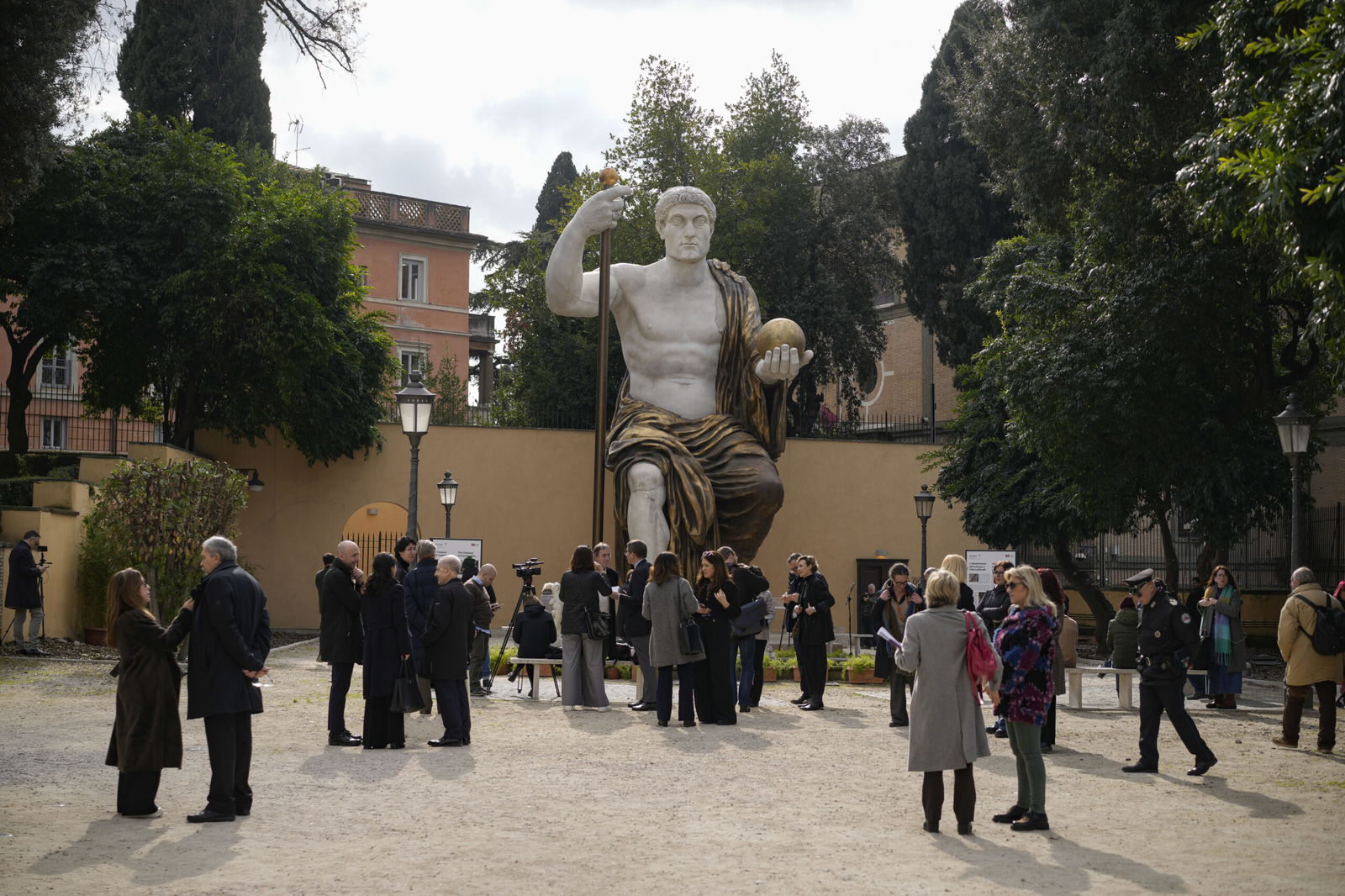Around the World briefs

By Associated Press
A giant statue of Emperor Constantine looks out over Rome again with help from 3D technology
ROME | Emperor Constantine, the 4th century ruler whose embrace of Christianity helped spread the faith throughout the Roman Empire, now has a reconstructed statue befitting his larger-than-life role in history.
Rome authorities on Tuesday unveiled a massive, 13-meter replica of the statue Constantine commissioned for himself after 312 AD. It was imagined using 3D modelling technology from scans of the nine giant original marble body parts that remain.
The result: An imposing figure of a seated emperor, draped in a gilded tunic and holding a scepter and orb, gazing over his Rome from a side garden of the Capitoline Museums. The reconstructed statue is just around the corner from the museum courtyard where the original fragments of Constantine’s giant feet, hands and head are prime tourist attractions.
Reconstituted into its original whole, the statue inspires awe in the smaller viewers below – just as Constantine originally intended for his subjects, officials said at the unveiling.
“In this statue there’s not just beauty, there’s the violence of power,” said Salvatore Settis, an archaeologist and art historian who is on the steering committee of the Fondazione Prada, the cultural and educational arm of the Milan-based fashion house which financed the project.
Officials declined to say how much the initiative cost, but the replica was made by the Factum Foundation, a Madrid-based nonprofit that creates high-resolution digital replicas of the world’s cultural patrimony.
“This whole dynamic about how you use technology to transform our understanding of and the importance of cultural heritage is the core mission of Factum Foundation,” said the group’s founder Adam Lowe.
The statue itself is made from resin, polyurethane and marble powder for the body, and gold leaf and plaster for the gilded tunic that drapes over it.
A second version of the statue is to be installed in northeast England, where Constantine guarded the Hadrian’s Wall fortification before being crowned emperor in Rome.
A pod of killer whales trapped
in drift ice off northern Japan
has apparently safely escaped
TOKYO | A pod of killer whales that was trapped in drift ice off Japan’s northern main island of Hokkaido, prompting concern from environmental groups, has apparently safely escaped, officials said Wednesday.
The killer whales, also known as orcas, were initially spotted by a local fisherman who reported them to officials in the nearby town of Rausu on the northeastern coast of Hokkaido on Tuesday morning.
Town officials traveled to the coast later Tuesday and saw about a dozen whales bobbing up and down in a tiny gap surrounded by drift ice, about 1 kilometer (half a mile) offshore.
After analyzing drone footage filmed by a conservationist group, officials counted 13 killer whales there.
The officials returned to the coast Tuesday evening and saw the pod had moved to the north, and it was gone when they returned again Wednesday morning, Rausu official Masataka Shirayanagi said.
Officials said they believe the killer whales were able to free themselves from the drift ice as gaps between them grew.
“We believe they were able to escape safely,” Shirayanagi said.
The footage, captured by a drone flown by a conservationist group and shown on NHK national television and on social media, prompted concern in and outside Japan about the whales’ conditions and pleas for the Japanese government to help. One group submitted a request to the Defense Ministry to mobilize an ice breaker to help free them.
Although the trapped whales were in Japanese waters, they were not far from an island that is disputed by Japan and Russia. Japan marked the annual Northern Territory Day on Wednesday to renew its demand for the return of the Russian-held islands.
The dispute over the islands, which the former Soviet Union seized from Japan at the end of World War II, has prevented the two countries from signing a peace treaty formally ending their war hostilities. Moscow announced it was cutting off negotiations with Tokyo over Japanese sanctions following Russia’s invasion of Ukraine.
Chief Cabinet Secretary Yoshimasa Hayashi told reporters on Wednesday that killer whales are not designated as an endangered species in Japan and that officials were monitoring the situation while Japan and Russia communicated over the issue.
102-year-old British veteran flies a Spitfire on a delightfully bumpy ride for charity
LONDON | A former Royal Air Forces pilot has taken to the skies in a Spitfire at 102 years old.
Jack Hemmings, an ex-squadron leader with Britain’s air force, is believed to be the oldest pilot to fly the World War II plane. His 20-minute flight, from an airfield in southern England on Monday, was to raise money for a charity he co-founded nearly 80 years ago.
The veteran — who had never flown a Spitfire before — said it was “absolutely delightful” being back behind the controls, though he said the ride was “very bumpy.”
“To be honest, it felt a bit rusty. Not surprising I am rusty,” he said.
Hemmings was raising funds for Mission Aviation Fellowship, a humanitarian air service he helped launch after WWII alongside D-Day veteran Stuart King. The organization has since grown into a Christian organization that uses planes to deliver relief, medicine and emergency cargo to countries in need.
The flight marked 80 years since the D-Day landings and paid tribute to King, who died in 2020.
Hemmings previously performed aerobatics on his 100th birthday and raised more than 40,000 pounds ($50,000) for the charity.
Barry Hughes, a pilot who accompanied Hemmings in the aircraft, said the veteran had a “natural touch.”
“He didn’t need any instruction really. He just took control, flown us around, made some turnings and basic maneuvers,” Hughes said. “I think he really enjoyed every single moment of the flight.”
Fossil fuel-dependent Puerto Rico can fully shift to clean energy by 2050, a federal study says
SAN JUAN, Puerto Rico | As Puerto Rico struggles with chronic power outages and a decaying electric grid, federal officials believe the U.S. territory can fully shift from fossil fuels to clean energy by 2050, according to a report Wednesday that has been two years in the making.
The report by the U.S. Department of Energy and the Federal Emergency Management Agency surprised those who thought that a recent law requiring Puerto Rico to reach 40% of clean energy by next year and 100% by 2050 was unrealistic.
“This transition will be a substantial effort and won’t happen overnight, but 100% clean energy is 100% possible,” said Agustín Carbó, Puerto Rico’s grid modernization director within the U.S. Department of Energy.
The department’s secretary, Jennifer Granholm, who traveled to Puerto Rico to help present the study, echoed Carbó’s comments, saying it was a “big, hairy audacious goal” that she believes can be accomplished.
Power plants that rely on coal, petroleum and natural gas currently generate about 97% of Puerto Rico’s electricity, with renewables accounting for only 3%, according to the U.S. Energy Information Administration.
The U.S. Department of Energy and the Federal Emergency Management Agency aim to change that.
As part of the push, officials on Wednesday announced a new federally funded program that will subsidize residential rooftop solar and battery storage systems for up to 30,000 low-income households on the island. Homeowners who qualify can start applying by Feb. 22.
Currently, some 110,000 individual solar systems are connected to Puerto Rico’s electric system, which serves around 1.2 million customers, and an average of 4,000 new solar systems are joining each month, said Gov. Pedro Pierluisi.
The two-year study found that Puerto Rico has more than tenfold the renewable energy resources required to meet the island’s demands through 2050, but that new infrastructure capable of generating hundreds of megawatts is needed.
Officials warned that such an investment could lead to additional rate increases on an island that already has a much higher electric rate compared with the U.S. mainland. Residential rates are 24 cents per kilowatt-hour, compared with an average of 16 cents in the U.S. mainland. Meanwhile, industrial rates are 25 cents per kWh, compared with 8 cents in the mainland.
“A strategic plan to control rate impacts while achieving better reliability over the near term is needed,” the report stated.
Rate increases are particularly concerning in Puerto Rico, which has the highest poverty rate compared with any U.S. state at more than 40% and has struggled to attract new investors as it emerges from the biggest U.S. municipal bankruptcy in history.
The report studying the shift to clean energy comes at a critical time.
“Puerto Rico’s current electricity system is complex, isolated, reliant on imported fuels, and vulnerable to extreme weather events and other natural hazards,” according to the report.
While ongoing power outages are partly blamed on Hurricane Maria razing the grid as a powerful Category 4 storm in September 2017, the problems began much earlier.
“Decades of operational, maintenance, and financial challenges have resulted in a system that lags far behind accepted reliability levels,” the report found.
The frequency and duration of power outages in Puerto Rico has worsened in recent years, with clients spending an average of 22 hours without power last year, according to a report submitted to the island’s Energy Bureau in late January.
The generational capacity of Puerto Rico’s power plants also has dropped from 52% to 42%, which officials with Genera PR, the company that operates and maintains such units, said was a result of temporarily taking them offline for maintenance.
The company said it expects ongoing projects to boost capacity to up to 60% sometime in the future.
Puerto Rico’s fragile power grid already depends on temporary generators installed last year to lessen the number of outages and allow crews to do maintenance. In a deal reached earlier this month with FEMA, the island’s government will operate the generators through the end of 2025.
The grid also will soon be backed by a battery energy storage system as part of a recently approved $648 million project funded with federal money.
—From AP reports



